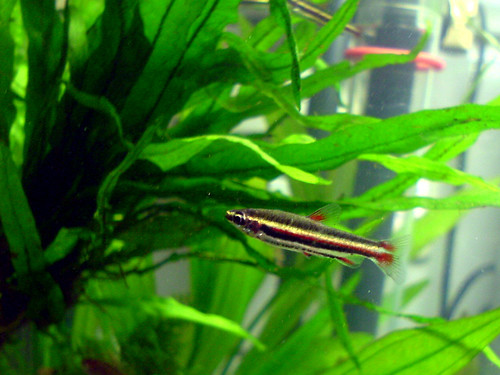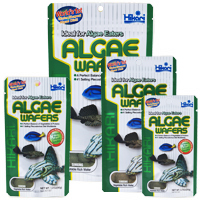Well, it took another ten days but now 2 of the three ancistrus are happily taking all sorts of food now. Hikari algae wafers are a favourite but also cucumber and shelled peas.
Like any hobbyist I'm always thinking about the next project even though the chances of actually creating such a project are remote. So I was wondering what a biotope aquarium would or could look like for this species. What we tend to forget is that a lot of species we keep in nicely planted aquariums (or kitsch monstrosities) come from rivers that feature little or no aquatic plants and the fish only get to meet plants in the rainy season when the rivers flood. Just look at this video of Neon Tetra in the wild:
Anyway, I've done some research into where these lovely little Ancistrus Claro come from. Turns out there's little information. Planetcatfish, pretty much the site to go to for any kind of catfish information, has this to say:
This species is found in Brazil, in the state of Mato Grosso, in the Rio Claro. It is also found in the Rio Coxipo and some small western tributaries.
Its natural habitat consists of fast flowing waters over a rocky bottom. Likes also to stay in quiet zones of these same river rapids. Safe will robust plants.
Fishbase disagrees a bit and says:
South America: Cuiabá River basin in upper Paraguay River drainage, Brazil.
Now.. I did a fair bit of googling but all you find for this region is information on the fish production of the region and on big game fishing. It's further complicated by the fact that there's Rio Claro all over South and Central America since it means "clear river".
What you do find if you google is references to the famous Heiko Bleher who pretty much grew up over there. Heiko creates beautiful biotope aquariums for special occasions. For Aqua-Fisch 2006 he made a Rio das Mortes biotope. Not the river system where Ancistrus Claro is found but close, at least the same state.
I got a bit frustrated by my search and decided to gamble. I wrote a polite email to Heiko asking what he knew. Figured I'd maybe get a reply in a few weeks if at all. Not that he's not a nice person but I expected him to be very busy.
To my astonishment I got an email back within four hours:
On habitat:
Well it is not correct that it is rocky ground and fast flowing. It is a normal flow and most of the habitat consists of sand (fine beige coloured), and driftwood, where they are mosty attached to/found. There grow Echinodoris species along the edges, which are submerse during the riany season. I would say you can use most of the Echinodorus, like E. bleherae, E. martii, E. latifolius, E. tenellus; etc.. There grows the floating Ludwiga helminthorrhiza; and L. inclinata. Also floating can be found Salvinia sp. Eichhornia crassipes and Azolla sp.
On tankmates:
Tankmates are: tetras: Hyphessobrycon melanopterus (small groups); Aphyocharax rhatbuni (also small groups); Nannostomus eques; N. trifasciatus; N. marginatus; catfishes: Corydoars sterbei; C. caudomaculatus; C. guapore; C. geryi; Otocinclus cf. affinis (could probably be any species you may ad); Rineloricaria cf. parva (could use several kinds, alwats 2-3); Platydoras costatus; cichlids: Apistogramma trifasciata; A. macilinesis; Mikrogeophagus altispinosa; Laetacara curviceps var., Cichlasoma boliviensis.
Echindorus are mostly a grassy looking family but Bleheri has broader leaves.. Ludwiga are finely build floaters that can even flower. Hyphessobrycon melanopterus is, apparently, also known as Hyphessobrycon callistus or possibly Heiko meant to type Megalopterus which is the well know black phantom tetra and from the same general area.
The next one we know and is also know as Redflank bloodtetra.

So, there's a nice looking schooling species.
Nannostomus are also known as pencilfish, here's marginatus:

Trifasciatus

And that's a very common, easy to obtain top level dweller. Rineloricariai is the twig-like catfish that has recently gained more interest, parva is the light coloured one.
So, there you have it. This could be done and the initial layout Heiko did back in 2006 is a feasible one. Get the slope, use a filler to keep from having all that sand on one end. Get some branches and pebbles in and plant clutches of echindorus. Or just sacrifice authenticity a bit and get some vallisnerea in as well.
I just wish I had a Rio 180 aquarium to start this project. :-)
Anyway, I've done some research into where these lovely little Ancistrus Claro come from. Turns out there's little information. Planetcatfish, pretty much the site to go to for any kind of catfish information, has this to say:
This species is found in Brazil, in the state of Mato Grosso, in the Rio Claro. It is also found in the Rio Coxipo and some small western tributaries.
Its natural habitat consists of fast flowing waters over a rocky bottom. Likes also to stay in quiet zones of these same river rapids. Safe will robust plants.
Fishbase disagrees a bit and says:
South America: Cuiabá River basin in upper Paraguay River drainage, Brazil.
Now.. I did a fair bit of googling but all you find for this region is information on the fish production of the region and on big game fishing. It's further complicated by the fact that there's Rio Claro all over South and Central America since it means "clear river".
What you do find if you google is references to the famous Heiko Bleher who pretty much grew up over there. Heiko creates beautiful biotope aquariums for special occasions. For Aqua-Fisch 2006 he made a Rio das Mortes biotope. Not the river system where Ancistrus Claro is found but close, at least the same state.
I got a bit frustrated by my search and decided to gamble. I wrote a polite email to Heiko asking what he knew. Figured I'd maybe get a reply in a few weeks if at all. Not that he's not a nice person but I expected him to be very busy.
To my astonishment I got an email back within four hours:
On habitat:
Well it is not correct that it is rocky ground and fast flowing. It is a normal flow and most of the habitat consists of sand (fine beige coloured), and driftwood, where they are mosty attached to/found. There grow Echinodoris species along the edges, which are submerse during the riany season. I would say you can use most of the Echinodorus, like E. bleherae, E. martii, E. latifolius, E. tenellus; etc.. There grows the floating Ludwiga helminthorrhiza; and L. inclinata. Also floating can be found Salvinia sp. Eichhornia crassipes and Azolla sp.
On tankmates:
Tankmates are: tetras: Hyphessobrycon melanopterus (small groups); Aphyocharax rhatbuni (also small groups); Nannostomus eques; N. trifasciatus; N. marginatus; catfishes: Corydoars sterbei; C. caudomaculatus; C. guapore; C. geryi; Otocinclus cf. affinis (could probably be any species you may ad); Rineloricaria cf. parva (could use several kinds, alwats 2-3); Platydoras costatus; cichlids: Apistogramma trifasciata; A. macilinesis; Mikrogeophagus altispinosa; Laetacara curviceps var., Cichlasoma boliviensis.
Echindorus are mostly a grassy looking family but Bleheri has broader leaves.. Ludwiga are finely build floaters that can even flower. Hyphessobrycon melanopterus is, apparently, also known as Hyphessobrycon callistus or possibly Heiko meant to type Megalopterus which is the well know black phantom tetra and from the same general area.
The next one we know and is also know as Redflank bloodtetra.

So, there's a nice looking schooling species.
Nannostomus are also known as pencilfish, here's marginatus:

Trifasciatus

And that's a very common, easy to obtain top level dweller. Rineloricariai is the twig-like catfish that has recently gained more interest, parva is the light coloured one.
So, there you have it. This could be done and the initial layout Heiko did back in 2006 is a feasible one. Get the slope, use a filler to keep from having all that sand on one end. Get some branches and pebbles in and plant clutches of echindorus. Or just sacrifice authenticity a bit and get some vallisnerea in as well.
I just wish I had a Rio 180 aquarium to start this project. :-)


No comments:
Post a Comment